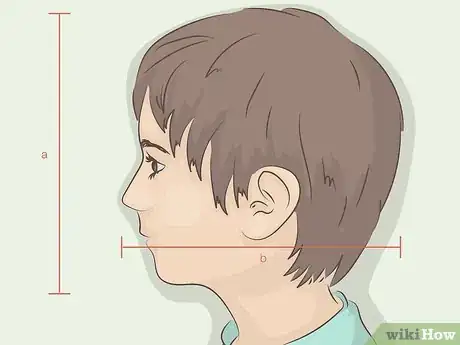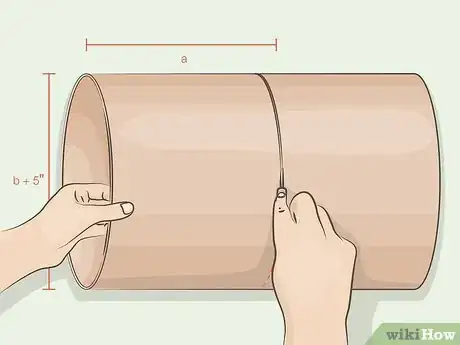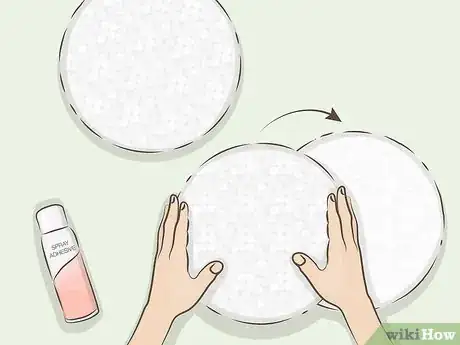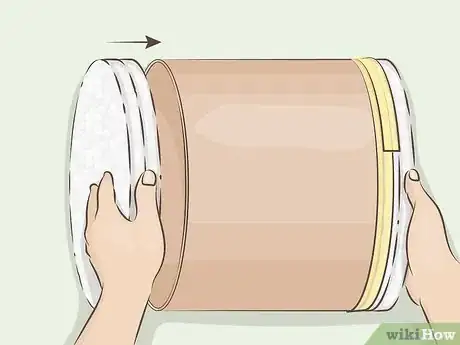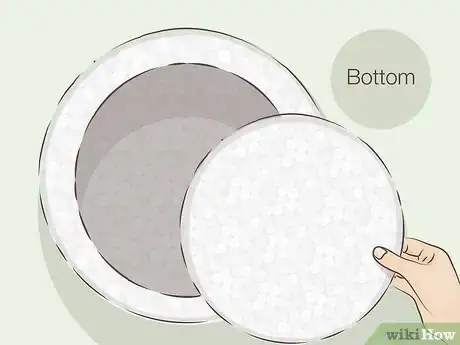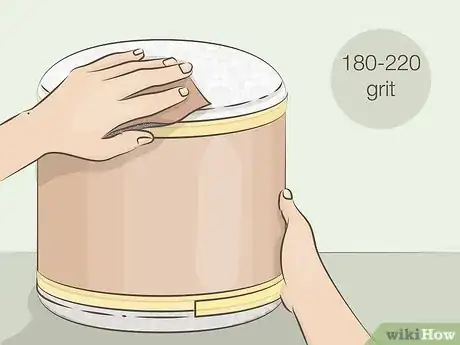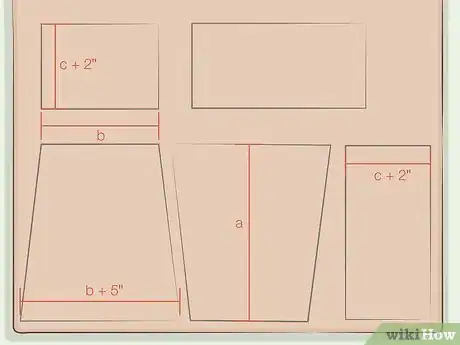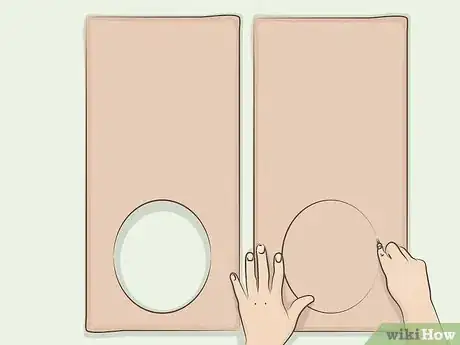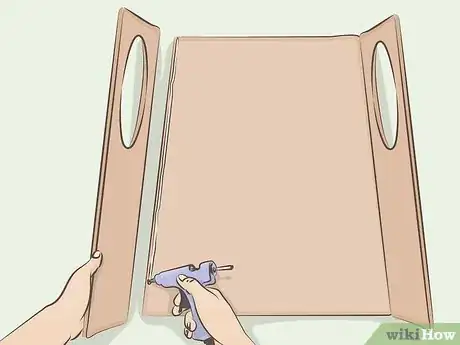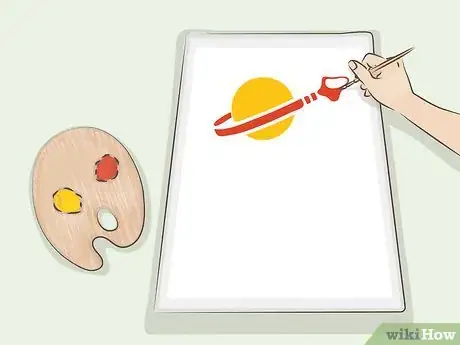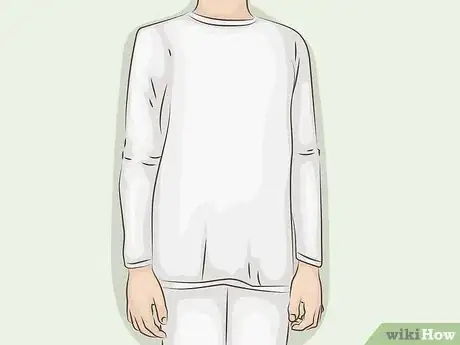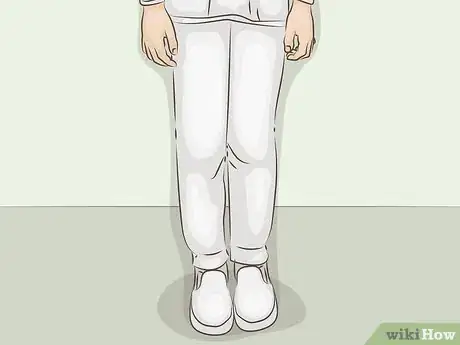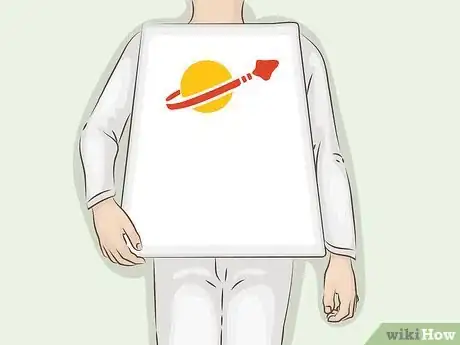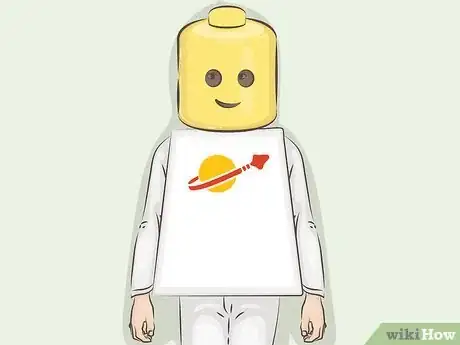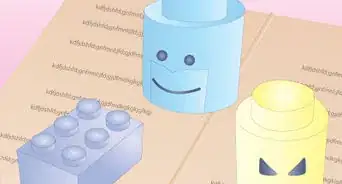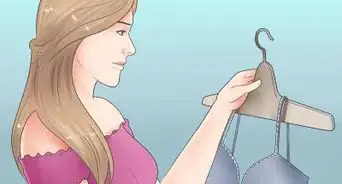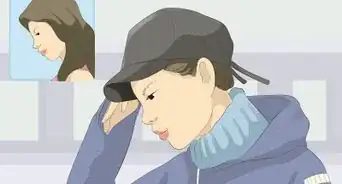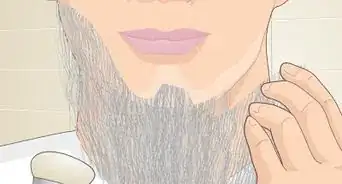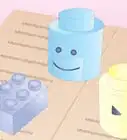This article was co-authored by wikiHow staff writer, Hunter Rising. Hunter Rising is a wikiHow Staff Writer based in Los Angeles. He has more than three years of experience writing for and working with wikiHow. Hunter holds a BFA in Entertainment Design from the University of Wisconsin - Stout and a Minor in English Writing.
There are 15 references cited in this article, which can be found at the bottom of the page.
This article has been viewed 350,991 times.
Learn more...
If you're feeling crafty before Halloween and want to make something that's easily recognizable, a life-sized LEGO figurine is an easy costume you can make at home. To make yourself into a LEGO person, all you need to build are the head and the body out of cardboard and foam. Once the pieces are assembled, you can paint them to have any design you want. When you're finished, you'll have a LEGO costume that's sure to impress others!
Steps
Building the Head
-
1Measure the diameter and height of your head. Hold the end of a flexible measuring tape at the tip of your nose and extend it toward the back of your head so you don't make the head on the costume too small. Then find the distance from the base of your neck to the top of your head so you know how tall the LEGO head needs to be. Write your measurements down so you don't forget them later.[1]
- Have a helper take the measurements for you if you're making the costume for yourself. That way, you'll be more accurate. If you can't find a helper, take your measurements in front of a mirror so you can see better.
-
2Cut a form tube so it's the same height as your head. Form tubes are thick cardboard cylinders that are usually used to form concrete pillars, so they are sturdy enough for your LEGO head. Get a tube that's at least 4–5 inches (10–13 cm) wider than the diameter of your head so you're still comfortable. Transfer the measurement for the height of your head onto the tube and carefully push a utility knife through it. Follow along the mark you made to cut completely around the tube.[2]
- You can buy forming tubes from your local hardware store or online.
- Don't use a tube that's too narrow or else the LEGO head will look too skinny and your head may not fit inside.
- Double check the inner diameter of the tube before you buy it since it may be different than the outer diameter.
Advertisement -
3Shape 1⁄2 in (1.3 cm) foam into 4 discs matching the tube's diameter. Use sheets of Styrofoam that are 1⁄2 in (1.3 cm) thick to make your discs. Trace the outer diameter of the form tubing on your foam 4 times so you can cut out each shape. Hold the foam steady with your nondominant hand and carefully along your outlines with a serrated bread knife. Follow as closely along the lines as you can so the discs are all the same shape.[3]
- You can buy sheets of Styrofoam online or from craft stores.
- Be careful so you don't break off pieces of the Styrofoam while you're cutting it.
-
4Make the top and bottom head pieces by gluing 2 foam discs together for each. Check that the foam discs line up perfectly when you stack them, and trim off any excess material with your knife. Apply a thin coat of spray adhesive to the flat sides of one of the discs and press a second disc on top of it. Make any adjustments quickly so the edges are flush. Repeat the process for the other 2 discs you cut. Let the spray adhesive dry for 10-15 minutes before handling the pieces again.[4]
- Work in a well-ventilated area since the spray adhesive may create harmful fumes.
- Avoid using hot glue or rubber cement since it could melt through the Styrofoam.
- Don't trim off too much foam or else the pieces will fall into the form tube.
-
5Attach the top and bottom pieces to the form tube. Set one of the pieces you just glued on top of the form tubing and line it up so the edges are flush. Slowly wrap a layer of masking tape around the seam between the foam and the tube, being careful not to leave any creases or raised edges. Go around the seam 3-4 times to hold it securely in place. Repeat the process to attach the bottom piece.[5]
- If the top and bottom pieces feel loose against the tubing, try using more layers of masking tape over the seam to hold it in place better.
- Rip or cut the tap into smaller sections so it's less likely to bend or leave visible creases.
-
6Remove a portion of the bottom foam piece so you can fit your head inside. Draw a circle in the center of the bottom piece that's 2 inches (5.1 cm) wider than the diameter of your head. Carefully stab your knife through the center of the circle and cut toward the outline you drew. Slowly work around the circle until you can fit your head into the tube.[6]
- You can trace a bowl or dish if you don't want to draw a circle freehand.
- Don't try to force your head into the tube since you could break the foam and need to build the bottom piece again.
-
7Sand the edges of the foam disks to curve them. LEGO figurines have smooth, rounded heads so work away any sharp corners with 180-grit sandpaper. Work around the top and bottom edge of the foam pieces until they have a gentle curve. Make sure the curve is the same all the way around the foam pieces so they look uniform.[7]
- Try switching to 220-grit sandpaper if you want better control of how much foam you're removing.
- Sanding foam can be messy and put foam particles in the air, so wear safety glasses and a dust mask while you're working.
-
8Glue a smaller foam disc in the center of the top piece. Cut another foam disc that has a diameter of about 2–3 inches (5.1–7.6 cm) and sand one of the edges so it's slightly rounded. Spray a small amount of spray adhesive onto one side of the smaller disc and press it onto the center of the top piece. Hold it there for at least 5 seconds while the glue sets.[8]
- The smaller disc on top of the head is the “stud” piece that LEGO figurines have so you can stack other things on them.
- Be careful not to press onto the disc too hard or else you could break through the top piece.
-
9Cut out eye holes so you can still see when you wear the head. Draw the face for your LEGO head on the side of the tubing large enough so you can see out of the eye holes. Use your utility knife to carefully pierce through the tube and cut out the area for your eyes. Try the head on to see if your eyes line up and to see how it limits your visibility.[9]
- You can also cut out the mouth shape if you want to be able to speak and breathe more easily.
Warning: The LEGO head may block your peripheral vision, so be careful and cautious of your surroundings so you don't get injured.
-
10Paint the head with a brush. Since spray paint can eat through foam, use a water- or oil-based paint with a foam brush to apply your color. Paint a thin layer of yellow paint onto LEGO to use as your base color. Let the paint dry completely before adding additional coats until the color is solid. Then, use black paint to add any details, such as eyes, the mouth, glasses, or freckles. Leave the paint to dry for at least 24 hours so it sets.[10]
- You may be able to find foam-safe spray paint at hardware stores.
Assembling the Body
-
1Take your body measurements so you know how large to sculpt the body. Start the end of a flexible tape measure at the top of your shoulders and extend it down to you your waist so you know how tall the body needs to be. Then measure from one end of your shoulders to the other so you know the width of the body. Take another measurement from the front of your chest to the bottom of your shoulder blades to see how deep you need to make the body.[11]
- Ask a partner to help you take the measurements since and can be difficult to find them on your own.
- Write down your measurements so you don't forget them.
-
2Draw the front, back, top, and side pieces of the body on sheets of cardboard. LEGO figurine bodies are trapezoidal prisms and can be easily made from scrap cardboard. Get a 4 in × 8 in (10 cm × 20 cm) cardboard sheet or old boxes so you have enough material for your LEGO body. Transfer your measurements to draw:[12]
- The front and back pieces: 2 trapezoids where the top bases are the same as your shoulder width and the bottom bases are 5–6 inches (13–15 cm) longer. Use your shoulder-to-waist measurement as the height of your trapezoid.
- The side pieces: 2 rectangles where the short sides are 2 inches (5.1 cm) longer than the depth of your chest and the others equal to the length as the angled sides on the trapezoid pieces.
- The top piece: 1 rectangle, where the long sides equal your shoulder width and the short side equals is 2 inches (5.1 cm) longer than your chest depth.
Tip: You can buy sheets of cardboard from craft stores or online.
-
3Cut the pieces out with a craft or utility knife. Set the cardboard on a work surface or cutting board so you don't damage anything underneath. Push the knife carefully through the cardboard and follow your outline as closely as you can so the pieces stay the same shape. Set all of your pieces aside as you remove them so you don't accidentally bend or break them.[13]
- Stack the pieces you cut out so you can see if they're the same shape. Trim off any excess cardboard so they look identical.
-
4Make a hole in the top piece large enough for your head to fit through. Use the same measurement you used to cut the hole in the bottom piece of the head. Place the hole directly in the center of the top piece so you can easily fit your head through it. Cut through the cardboard with your utility knife and set it on your head to see if slides on easily. Make any adjustments you need until your head comfortably goes through the hole.[14]
- Try sanding the edges of the cardboard slightly to help smooth out any sharp edges that your head might get caught on.
- Don't put the hole too close to the edge or else your LEGO body won't stay together very well.
-
5Use your knife to cut holes for your arms in each of the side pieces. Measure in 1–2 inches (2.5–5.1 cm) from one of the short ends of the side pieces and mark it as a starting point for your armhole. Measure the widest point of your arm and make your holes large enough for them to fit through. Use your utility knife to make clean cuts through the cardboard pieces.[15]
- Don't make the hole too small or else the cardboard will bend when you put your arms down.
- Be careful not to position the holes too close to the sides since it could make the sides weaker.
-
6Glue the pieces together to form the body. Lay the back-piece on your work surface and hold one of the side pieces vertical along the edge. Place a line of hot glue in the corner between the pieces and hold it in place until it dries. Glue in the top piece and the other side piece and let it dry completely. Gently flip the body over and set it on the front piece so you can glue it in place.[16]
- After the glue dries, place a layer of 1 in (2.5 cm) masking tape on each corner for an additional layer of support.
-
7Paint the body for whatever color and design you want. Set your LEGO body in a well-ventilated area and hold a can of spray paint 6 inches (15 cm) away from it. Apply a thin coat of the spray paint onto the body and let it dry for about 15 minutes. Apply additional coats and let them dry for 15 minutes each until the paint has a smooth finish. Use a foam brush with acrylic paint to add any small details, like seams, buttons, or designs to the body.[17]
- Look at the body designs for real LEGO figurines to get inspiration for your design.
Putting the Costume Together
-
1Wear an undershirt that matches the color of the LEGO body. Find a shirt in your closet that's similar or the same color as whatever color you painted the body. You can either choose a short-sleeved or long-sleeved shirt for your costume. Put the shirt on so the sleeves come out through the armholes and tie your look together.[18]
- If you don't have a shirt that matches the color of your LEGO body, then you can either buy one or dye clothes yourself.
- Even if you want your LEGO costume to look “sleeveless,” wear a yellow shirt since LEGO figurines are yellow.
Tip: Put on yellow gloves and keep your fingers in a C-shape as often as you can to look like actual LEGO hands.[19]
-
2Put on solid-colored pants and shoes that are the same color. The leg and foot pieces on a LEGO figurine are typically the same color, so look for pants and shoes that match one another. Find something comfortable to wear and matches the outfit on the rest of your LEGO body. Look for closed-toed shoes, like boots or sneakers, to help them blend in with your pants more.[20]
- You can try using boxes to make LEGO legs, but they are difficult to walk in and uncomfortable.
-
3Slide the body piece over your arms and head. Stick your arms out above your head and reach through the bottom of the LEGO body. Put your hands through the armholes and shimmy the body down until you can slide your head through. Pull the body down so it's flat on your shoulders so you comfortably move around.[21]
- Don't try to put your head through the hole before you put your arms in since you'll deform the cardboard and break the body.
-
4Place the LEGO head on so you can see out of it. Grab the LEGO head and position the eyeholes on the front side so you can see. Slowly set it onto your head so it doesn't break or fall down too fast. Readjust the head again until you can look straight ahead without obstructing your vision.[22]
- The LEGO head may wobble around while you're wearing it, so you may need to adjust it throughout the day.
Warnings
- Work in a well-ventilated area when you're using spray adhesive or spray paint since they could create harmful fumes.⧼thumbs_response⧽
- The LEGO head may block your vision so you may not be able to see as well.⧼thumbs_response⧽
Things You'll Need
- Styrofoam
- Flexible tape measure
- Form tubing
- Utility knife
- Bread knife
- Spray adhesive
- Masking tape
- 180-grit sandpaper
- Safety glasses
- Dust mask
- Water- or oil-based paint
- Paintbrushes
- Cardboard boxes or sheets
- Compass
- Hot glue gun
- Yellow gloves
References
- ↑ http://warfieldfamily.com/2010/11/lego-costume-construction/
- ↑ http://warfieldfamily.com/2010/11/lego-costume-construction/
- ↑ https://youtu.be/xne0qjhFVNY?t=87
- ↑ https://youtu.be/4U_TQd_9tqU?t=40
- ↑ http://warfieldfamily.com/2010/11/lego-costume-construction/
- ↑ http://warfieldfamily.com/2010/11/lego-costume-construction/
- ↑ https://youtu.be/Y0ZBSytX4p8?t=133
- ↑ http://warfieldfamily.com/2010/11/lego-costume-construction/
- ↑ http://warfieldfamily.com/2010/11/lego-costume-construction/
- ↑ https://youtu.be/nkgeK1__0t4?t=627
- ↑ https://youtu.be/3ZSfY87v6pM?t=71
- ↑ https://youtu.be/hUHGkI3S2TQ?t=232
- ↑ https://youtu.be/hUHGkI3S2TQ?t=324
- ↑ https://youtu.be/hUHGkI3S2TQ?t=522
- ↑ https://youtu.be/hUHGkI3S2TQ?t=436
- ↑ https://youtu.be/hUHGkI3S2TQ?t=577
- ↑ https://youtu.be/hUHGkI3S2TQ?t=968
- ↑ http://sewwoodsy.com/2013/09/diy-lego-costumes.html
- ↑ https://youtu.be/oGkjVbTkpEo?t=263
- ↑ http://warfieldfamily.com/2010/11/lego-costume-construction/
- ↑ https://youtu.be/hUHGkI3S2TQ?t=1046
- ↑ http://sewwoodsy.com/2013/09/diy-lego-costumes.html
